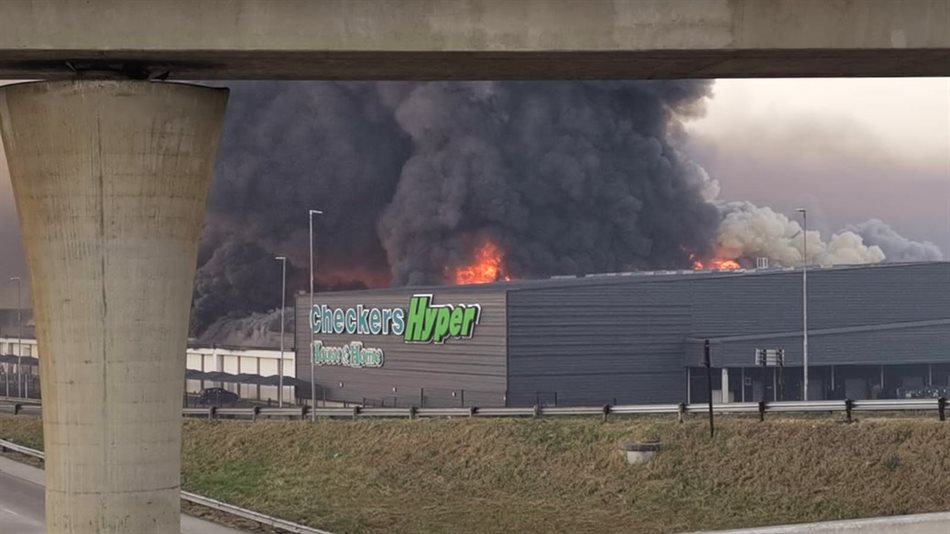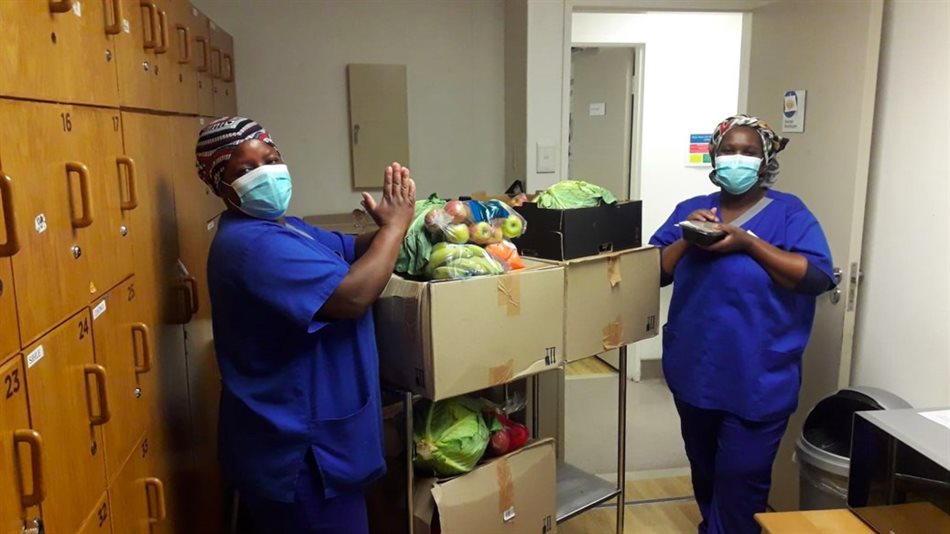
The Brookside Mall on fire during the Pietermaritzburg riots in July 2021
Not only did the hospital have to navigate through the pandemic, especially the extreme waves in January and February of 2021, but had to contend with civil unrest, rioting and looting in the town in which it is situated.
Add to that a supercell storm on the 22 December 2021, in Pietermaritzburg a few months later. It uplifted trees and created havoc in the city. The hospital in the centre of the capital, Mediclinic Pietermaritzburg, flooded. Theatres, CSSD and ICUs were negatively impacted, with water and hail overwhelming the drainage system outside.
One of the staff members helping to mop up the water likened the flood to a cleansing ceremony for the hospital after the year they had been through.
Mediclinic Pietermaritzburg is a private hospital that was hard hit and the people working at the hospital described it as 'working under apocalyptic-like conditions'. “We were so significantly impacted by the second wave of Covid-19 in January 2021 that we were on the brink of running out of resources in the KZN province. There were no private hospital beds left to transfer patients out to,” says hospital general manager, Tabitha Lolliot.
These were things you read about in a disaster management situation that now became our reality. I remember a phone call one Friday night at about 10pm when I was told that the hospital oxygen access points in our ICU and High Care were all in use and patients were still arriving at the emergency centre. The hospital was able to provide additional access to high care beds in other units to ensure that we could assist these patients. It was very stressful. We had to make do with what we had at the time and keep phoning to locate capacity in the different provinces to transfer patients.
The looting and violence of July 2021 impacted our hospital in a major way. Ambulances and oxygen supplies could not get through some areas that were like war zones. We had to bring in our oxygen deliveries under security protection. The main highways were shut and so it impacted our food and fuel supplies.
On Monday 12 July, when the unrest started, by 6am, we already had about 60 staff members that had phoned in to say they could not get to the hospital. Those that did get through arrived very traumatised because they had to drive on pavements to avoid all the rocks and broken glass on the roads. Some were even shot at. We had to close our vaccine site because it wasn’t safe for people to come into the hospital. We had to convince nearby shops to accept bulk orders for food from us. These bulk orders would arrive by ambulance to stop looters from attacking them. The bulk order list included toothpaste and toothbrushes because we had staff sleeping overnight to avoid having to travel through troubled areas.
Every night at least three members of hospital management would sleep at the hospital to provide support to the staff and patients. There was no fuel available, so staff had to create lift clubs. Even then, many were running on empty tanks.
One of our catering staff walked 16km to get to work. Many of our nurses pulled double shifts and stayed over in the hospital, especially our ICU staff. That was the level of commitment.
The other serious impact was the lack of supply of medical consumables and medicines. Two medical supply factories in Durban were torched, one of them our main supplier. Mediclinic corporate office came to the rescue and arranged a helicopter to land at the hospital with essential supplies. They also arranged food parcels for all the staff, which were delivered when the national roads opened.

Food parcels being delivered to the hospital via helicopters due to roadblocks following riots
The violence also resulted in an increase in trauma cases like car crashes and gunshot wounds, which impacted on our theatres. We had tried to limit theatre cases due to the demand on resources for the management of Covid patients.
We had different challenges with the different Covid waves. In the first wave with the level-five lockdown our biggest challenge was human resources because that’s when our staff were getting sick. We have a staff complement of 500 and on one day we had 120 staff members off duty – either because they had a high-risk exposure, or they had tested positive, or they were symptomatic. Fortunately, that wave was less significant regarding high patient numbers.
We started to think our way around problems, for example, how were we going to manage high patient loads in the ICUs? We did this through the introduction of team nursing. In effect, this meant that instead of one-on-one nursing, a team of two or three nurses would look after three or four patients. They would move as a team to take care of patients.
With the human resources shortage where people were getting sick, we analysed what was going on and identified the issues (why staff were getting ill) and put a PDSA cycle in place. We identified our tea lounges as being a problem, this is where staff met for their breaks. We also identified the lift clubs as a problem. So, we put actions into place to mitigate these risks.
The nurses would all go home in one car without masks. One person would get exposed and the whole group would get sick. There were lift clubs with people from different departments, we had to trace where each person was working, and who was in that lift club, where they had tea. We created a tea-time rota so that they were not all together at the same time. We created space outside in the gardens so they could have tea breaks in the fresh air and not cross infect each other.
“Thinking our way out of these problems was possible because we had great support from our Mediclinic corporate office. But I believe it is also because we have been accredited several times by the Council for Health Service Accreditation of Southern Africa (Cohsasa). This means that thinking through problems and meeting rigorous standards are embedded in our everyday operations and this gave us the operational resilience we needed to meet these different crises,” said Lolliot.
1The PDSA cycle is shorthand for testing a change by developing a plan to test the change (Plan), carrying out the test (Do), observing and learning from the consequences (Study), and determining what modifications should be made to the test (Act). Definition courtesy of the Institute for Healthcare Improvement, Boston, Massachusetts, USA.
Allowing patients to be part of the healing process
Hospital general manager of Mediclinic Midstream, Dr Shane Kotzé, shared some of the challenges faced during the Covid-19 pandemic as well as their innovative approach to involving the patient in their own healing process.
Hospitals were under enormous pressure due to the severity and volumes of patients during the peaks of the pandemic. Resources were at capacity and teams had to identify new ways of doing things to facilitate the care required by patients. Kotzé details how new patient flow patterns were implemented including the introduction of an additional step in the escalation or de-escalation of care which unfortunately still saw resources under pressure.
One of the concepts that was trialled during the second wave was satellite high-care units. Looking back at the data, more than a hundred patients had critical events where they needed unplanned escalation in the level of care to ICU. Kotze adds that healthcare workers are trained to do something in a certain way with these associated processes that limit risks and follow set clinical pathways. However, during this period, there were expectations for them to deliver care to the patients, but they were unable to do so due to the excessive demands made by the volume of patients.
“We had employees who were emotionally exhausted, especially after the second wave. It was in the third wave that we recognised that we were approaching the same challenges again,” he explains. During an early morning huddle, a long discussion was held about what clinical options were available, and how learnings from other parts of the world could assist the teams. The concept that resulted from those discussions was simple: ‘Let’s change it’, By taking the latest thinking in patient safety and empower patients to aid in their own observations of their condition. In other words, let’s give them information. This process was implemented by a senior nurse who ensured that the roll-out process was carefully supervised.
The need for quick adoption by patients was treated with high priority to alleviate the pressures on healthcare workers. Kotzé further explains that the roll-out to patients needed to maintain care: “We explained to patients about our priority to support them during recovery, and that we want to help them to recover as fast as they feel comfortable to do so,” Kotzé adds.
Patients were issued with pulse oximeters to measure the oxygen saturation levels in their blood and were shown how to use them, the benefits of proning were also highlighted. “We indicated that saturation levels above 92 were ideal and we asked patients to check and record their own readings and call for assistance if needed,” he continues. If patients found their levels were dropping, their oxygen intake was adjusted upwards and vice versa. They monitored themselves and critical events dropped to one in the third wave.
“Patients were informed about the metric they could use to empower themselves, to seamlessly understand whether their condition was improving or deteriorating. They were also advised that when their oxygen levels had to be adjusted, they were to change their position and offered further guidance on proning. A nurse would visit the patients every hour to document their vital data,” concludes Kotzé.
Mediclinic’s decision to empower the patient to be part of their own healing process proved to be successful even after discharge because patients knew how to monitor their oxygen levels at home. The time to discharge also decreased significantly which was a great stepping stone for the hospital group, its patients and the health sector as a whole.